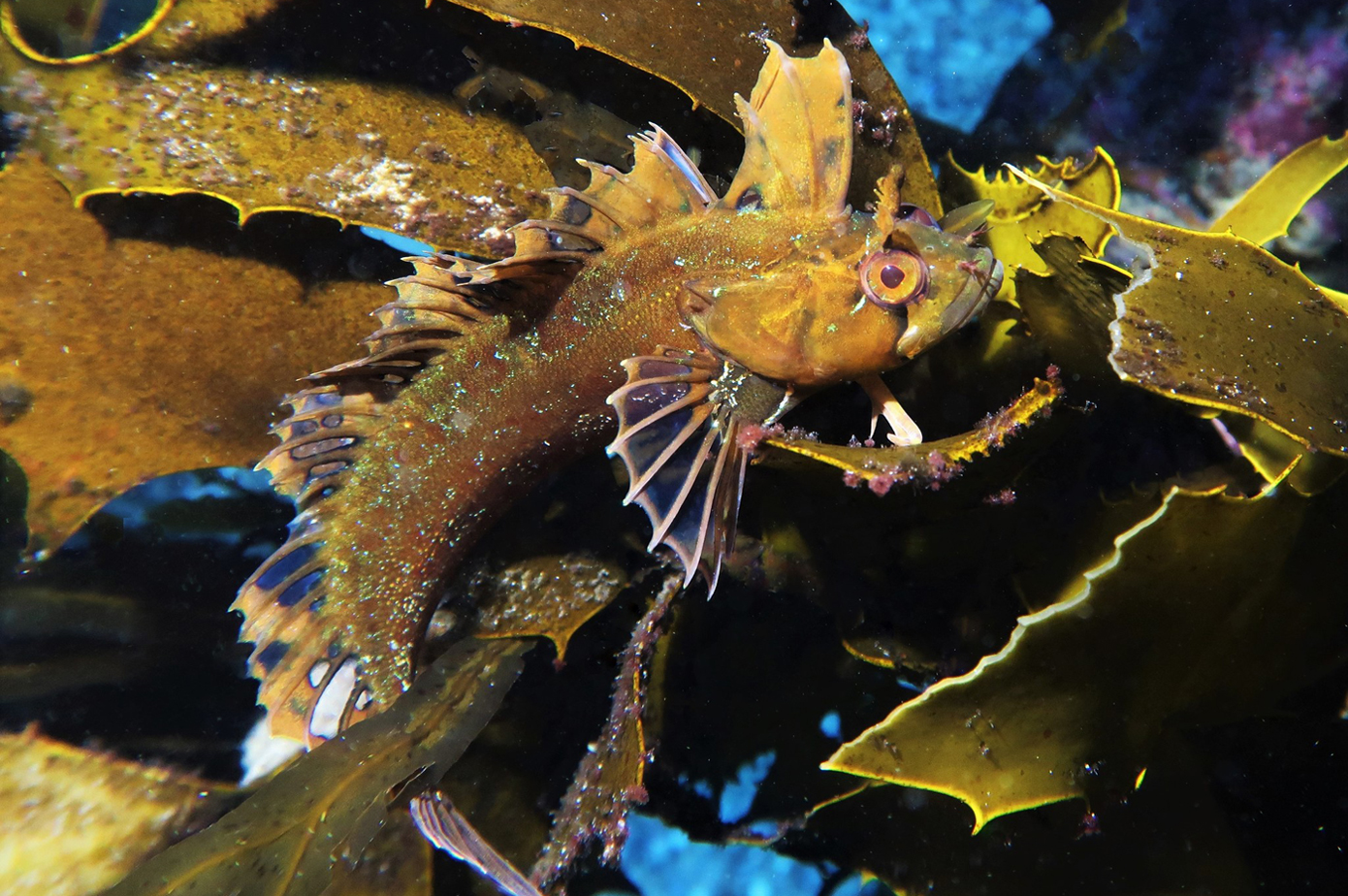Rosy Weedfish, Heteroclinus roseus (Günther 1861)
Other Names: Brown Weedfish, Pink Weedfish

A Rosy Weedfish, Heteroclinus roseus, at Minnie Water, New South Walas, May 2020. Source: @lizzydem / iNaturalist.org. License: CC by Attribution-NonCommercial
Summary:
A mottled yellowish, reddish to brownish weedfish with 7 reddish marbled bands extending onto the dorsal and anal fins, a blackish blotch surrounded by white on the middle of pectoral-fin base, mottled fins with transparent areas and a dark margin, and free tips on the dorsal-fin spines.
The Rosy Weedfish has a relatively large orbital tentacle that is simple, crenulate, or has a rounded tip with several lateral lobes. The nasal tentacle has 3-4 slender lobes.
The Rosy Weedfish has a relatively large orbital tentacle that is simple, crenulate, or has a rounded tip with several lateral lobes. The nasal tentacle has 3-4 slender lobes.
Cite this page as:
Bray, D.J. 2022, Heteroclinus roseus in Fishes of Australia, accessed 01 Jul 2025, https://fishesofaustralia.net.au/Home/species/8
Rosy Weedfish, Heteroclinus roseus (Günther 1861)
More Info
|
Distribution |
Minnie Water, New South Wales, around southern Australia, to Shark Bay, Western Australia; also Lord Howe Island and Norfolk Island in the Tasman Sea. Records from tropical areas outside Australia are most likely misidentifications of the weedfish Springeratus. Inhabits macroalgal covered reefs. |
|
Features |
Dorsal fin III, XXIV-XXVII, 3-5; Anal fin II, 19-22; Caudal fin (segmented) 9-11; Pectoral fin 11-13; Pelvic fin I, 3; Lateral line scales (arched) 16-25 + (straight) 20-29; Gill rakers 1-2 + 6-8 = 7-10. Body moderately deep, strongly compressed; two dorsal fins connected at most near base, first dorsal fin arising over or behind rear margin of eye. |
|
Colour |
Colour variable, mottled, yellowish-red to deep pinkish-red or brown; 7 reddish marbled bands along the side, broken into sections and extending onto dorsal and anal fins; blackish blotch surrounded by white on middle of pectoral-fin base; dorsal, caudal and anal fins mottled with a dark edge and transparent areas; head mottled with large white spots on mouth, cheek, operculum, pectoral-fin base and abdomen; short dark bar posterior to middle of eye, second oblique dark bar posteroventrally from eye to rear end of pectoral-fin base. |
|
Biology |
Weedfish have internal fertilisation and females give birth to live young. |
|
Etymology |
The specific name is from the Latin roseus (= rose-coloured) in reference to the rosy colour of this species (the colour varies greatly in this species). |
|
Species Citation |
Cristiceps roseus Günther 1861, Cat. Fishes Brit. Mus. 3: 274. Type locality: Freycinet's Harbour, Western Australia; New Guinea. |
|
Author |
Bray, D.J. 2022 |
|
Resources |
Rosy Weedfish, Heteroclinus roseus (Günther 1861)
References
Francis, M.P. 1993. Checklist of the coastal fishes of Lord Howe, Norfolk, and Kermadec Islands, Southwest Pacific Ocean. Pacific Science 47(2): 136-170.
Francis, M.P. 2019. Checklist of the coastal fishes of Lord Howe, Norfolk and Kermadec Islands, southwest Pacific Ocean. Version: 2019.2 figshare. Collection. https://doi.org/10.6084/m9.figshare.c.4428305.v2
Fricke, R., McEachran, J. & Williams, J.T. 2010. Heteroclinus roseus. The IUCN Red List of Threatened Species 2010: e.T154958A4677100. http://dx.doi.org/10.2305/IUCN.UK.2010-4.RLTS.T154958A4677100.en. Downloaded on 17 August 2016.
Günther, A. 1861. Catalogue of the Fishes in the British Museum. Catalogue of the acanthopterygian fishes in the collection of the British Museum. London : British Museum Vol. 3 586 pp.
Hoese, D.F., Gomon, M.F. & Rennis, D.S. 2008. Family Clinidae. pp. 696-722 in Gomon, M.F., Bray, D.J. & Kuiter, R.H. (eds) Fishes of Australia's Southern Coast. Sydney : Reed New Holland 928 pp.
Hoschke, A., Whisson, G. & Moore, G.I. 2019. Complete list of fishes from Rottnest Island. pp. 150-161 in Whisson, G. & Hoschke, A. (eds). The Rottnest Island fish book. 2nd ed. Perth : Aqua Research and Monitoring Services.
Hutchins, J.B. & Swainston, R. 1986. Sea Fishes of Southern Australia. Complete field guide for anglers and divers. Perth : Swainston Publishing 180 pp.
Kuiter, R.H. 1993. Coastal Fishes of South-eastern Australia. Bathurst : Crawford House Press 437 pp.
Kuiter, R. & Kuiter, S. 2018. Coastal sea-fishes of south-eastern Australia. Seaford, Victoria : Aquatic Photographics, 371 pp.
McCulloch, A.R. 1908. Studies in Australian fishes, No. 1. Records of the Australian Museum 7(1): 36-43 pls 10-11 https://doi.org/10.3853/j.0067-1975.7.1908.949
Rennis, D., Hoese, D.F. & Gomon, M.F. 1994. Family Clinidae. pp. 741-775, figs 650-684B in Gomon, M.F., Glover, C.J.M. & Kuiter, R.H. (eds) The Fishes of Australia's South Coast. Adelaide : State Printer 992 pp. 810 figs.
Thomson, J.M. 1978. A Field Guide to the Common Sea & Estuary Fishes of Non-tropical Australia. Sydney : Collins 144 pp.
Waite, E.R. 1904. New records or recurrences of rare fishes from eastern Australia. No. 3. Records of the Australian Museum 5(4): 231–244 https://doi.org/10.3853/j.0067-1975.5.1904.1055
Whisson, G. & Hoschke, A. 2021. The Perth coast fish book. Identification guide Mandurah to Two Rocks. Perth : Aqua Research and Monitoring Services, 290 pp.
Whitley, G.P. 1931. New names for Australian fishes. The Australian Zoologist 6(4): 310-334 1 fig. pls 25-27 (described as Petraites sellularis, type locality Balmoral Beach, Sydney, NSW) See ref at BHL







